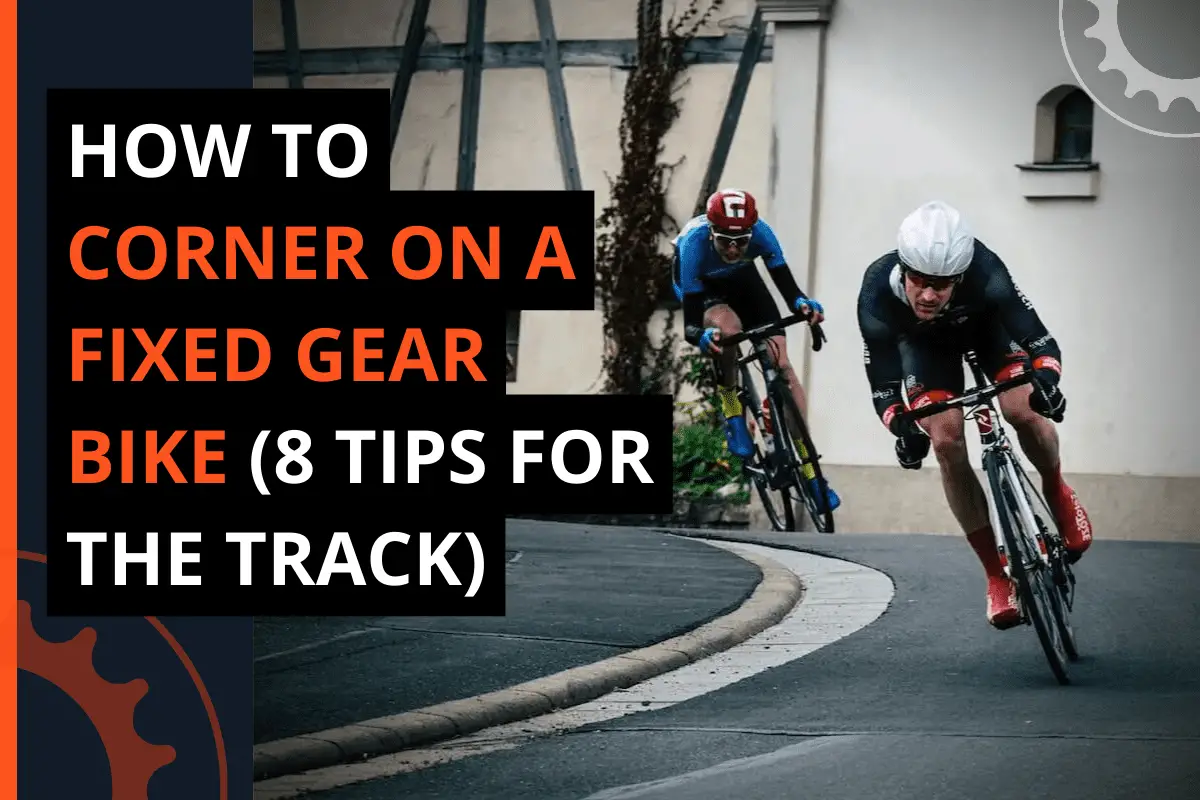Cornering is a skill that every cyclist must know how to do effectively. Learning to corner correctly on a bike is vital. It’s not just about going faster when it comes to corners; it’s also about having more control over your bike, making your journeys safer and more pleasurable. But what is cornering, and how do you corner on a fixed gear bike?
Cornering on a fixed gear bike is similar to cornering on a road bike. The main difference is, of course, that on a fixed gear or a track bike, you do not stop pedaling. Keep the pedals engaged. If you have other things to keep in mind, use your drop bars, use the brakes before getting to the corner, and keep your eyes forward.
But there’s a lot more to it than that. So, in this article, you will learn what cornering is, why it’s an important skill, and how to do it effectively to fly past the competition.
Editor’s note: This article was updated on June 9, 2022, to include additional information regarding cycling performance.
What is cornering?
Cornering is the act of making aggressive angled turns while doing all you can to maintain speed and control. Track cyclists must be able to corner well to win a velodrome race. When you turn a corner, you must lean into the curve. Imagine your bodyweight steering you in the direction you want to go.

It is highly recommended to use drop bars when cornering on any bike. Using drop bars lowers your center of gravity and improves your aerodynamics. However, if you don’t have drop bars, check out some fixie drop bars below.
[azonpress template=”grid” asin=”B0734YH15L,B08VYGTQ1M,B08X22TRZR”]
State Bicycle Co. Black Label 6061

State Bicycle Co. Black Label 6061
How to corner on a fixed gear bike
Knowing how to corner is a skill that every cyclist must learn, or at least know the basics of. It will significantly enhance your writing experience. Here’s how to corner on a fixed gear or track bike.
Keep the train in mind when cornering
Keep an eye out for sand, rocks, dirt, gravel, or fissures that could cause you to slip. When you add rain to the equation, your strategy changes even more. In wet weather, painted lines, maintenance hole covers, and oily pavement become slick. Everything you do is magnified on wet roads. When the bike is leaning, braking makes it easier to skid, and turning too quickly might cause your wheels to slip—slow down.
Use your drop bars
Lowering your center of gravity by placing pressure on the front wheel while riding in the drops provides you with more traction and control on the bike—not to mention that you’ll be faster and more aerodynamic! If you don’t have drop bars, these drop bars are really popular on Amazon.
Brake sooner than later
You’ve probably heard that you should brake before entering a corner. And we agree that, in an ideal world, you’d do exactly that. However, you may need to keep braking on downhill curves (especially hairpins) if you don’t want to pick up too much speed.
Any braking during cornering should be smooth and light. If you need to do it, do it gently and sparingly.
Use your bodyweight
While you may have a firm grip on your handlebars, leaning is what causes a bike to turn quickly. It’s all about moving your center of gravity to balance the bike.
The faster you corner, the more you need to learn to keep your balance. The tires can no longer provide enough traction to keep you upright, so excessive leaning is not helpful, and sometimes the line between success and failure is thin.
Fly through the apex
Apexing is the fastest way to take a bend, so it’s worth mentioning. Simply put, apexing a bend involves flattening the curve as much as possible by taking a broad line into and out of the turn.
The flatter the curve, the faster you can safely go around it, or to put it another way, the quicker you can go through it, the safer you will be, as you won’t be struggling for grip or reaching for the brakes in a panic. Remember that you can still apex a corner and stay on the right side of the road.
Keep your eyes forward
Take a look at the direction you want to go in. Keep your gaze fixed on the spot where you want to exit the corner, and your body will adapt your leaning, steering, and line accordingly. If you’re worried about not making it around the bend and ending up in the ditch, try not to focus on that ditch because if you do, that’s where you’ll end up.
Check your speed when cornering
Slow down before the corner, braking while still upright and traveling straight.
In reality, you can’t see far enough around the bend or predict every outcome, so you must adjust your pace. But there are ways to make it safer. However, don’t brake too hard if you want to slow down.
Don’t tense up
Your body’s first reaction will likely be to get tense in a corner. However, tensing up will only worsen things, so stay relaxed, especially in your upper body.
If you are tense, you might grab the brakes. And if you grab the front brake, you risk a washout (sliding out from under you) as the back wheels might lock up. Locking the rear wheel causes a broadside speedway skid that may be difficult to recover from.
Don’ stop pedaling
Road cyclists don’t have this problem. However, if we’re talking about fixed gear bikes, you cannot coast. Much like sharks have to keep swimming, fixies have to keep pedaling. So don’t get complacent, and don’t stop pedaling when you’re nearing the corner. Keep those pedals engaged.
Fly out of the turn with speed
You should have just gracefully rounded the corner if you followed the preceding steps. You need to return the bicycle to its upright posture and resume pedaling as fast as possible!
If you want to see an example of this in action, take a look at this video called “Fixed Crit Training | Cornering Explained” from the Juliet Elliott YouTube Channel.
Tips for cornering on a fixed gear bike
Here are a few more tips for cornering.
The ‘Dos’ of cornering on a bike
- Familiarize yourself with the bike and handle it in various situations, such as wet and dry roads.
- Look ahead of time to assess an upcoming bend properly.
- Keep your eyes on the exit of the corner, even if you deviate from your original line.
- Keep calm, even if it’s hard. If you can, most of those little “moments” will be nothing more than a heartbeat and an adrenaline rush.
The ‘Don’ts’ of cornering on a bike
- Don’t grab the brakes hard when cornering, or you’ll end up on the asphalt.
- Don’t hang off your bike. Keep your weight close to the bike for maximum control and grip.
- Don’t take unnecessary risks. Going into a hot corner and overcooking it often results in more loss than gain. The safest approach is slow in and fast out.

How to make sharp turns on a bicycle by countersteering
If you come across a particularly sharp bend or just wish to approach a corner faster (maybe for a race-winning breakaway), here’s a method that can assist.
Simply countersteer right before approaching the corner. Countersteer with the handlebar as you approach the turn. You’ll be centered over the bike, and your weight will be on the outside leg, but just before you lean in, quickly pull the handlebar back with your outside hand like you are turning the wrong way. For example, if you’re turning right, you’ll slide the handlebar to the left.
Just a little pull and then relax, allowing the bar to return to its original position. By pointing in the incorrect way for a fraction of a second, you will actually make a sharper turn in the desired direction! After that little pull, the bike will start the dive for you.
Frequently asked questions (FAQ)
Below are some commonly asked questions regarding cornering on a fixed gear bike.
What does it mean to corner on a bicycle?
A corner’s principal purpose is to escape faster than you entered. That means brake control, gear selection, and departure commitment. On the approach, shift into a lower gear to accelerate out of the bend.
What is counter steering?
Single-track vehicles like bicycles use countersteering to initiate a turn by momentarily steering in the opposite direction of the desired turn (“steer left to turn right”). To effectively navigate a turn, the combined center of gravity of the rider and single-track vehicle must first be leaned in the direction of the turn. This lean is caused by a momentary steering input in the opposite direction. Countersteering is sometimes described as “providing a steering order” by riders.
Do I need to know how to corner?
Practice on gentle terrain. Cornering on rough terrain can be dangerous and can easily throw you off your bike. Instead, start by practicing on gentle slopes and hills until you get the hang of it. You’ll be able to handle challenging corners much better this way. Always pay attention to your speed and distance when cornering—even if you think you’re going slow enough, there’s always the risk of an accident. If in doubt, always slow down!
Conclusion
Cornering is critical for learning how to ride your track, fixie, or single-speed bike efficiently. Now that you are armed with some information on how to corner, I am sure you are ready to take on the track faster than ever.
This article covered what cornering and countersteering are, how it is done effectively, and some dos and don’ts of cornering. Here are some key takeaways:
Key takeaways
- Keep the train in mind.
- Use your drop bars.
- Brake sooner than later.
- Use your body weight.
- Fly through the apex.
- Keep your eyes forward.
- Check your speed when cornering.
- Don’t tense up.
- Don’t stop pedaling.
So, are you a cornering king? Let me know in the comments below (I read and reply to every comment). If you found this article helpful, check out my full blog for more tips and tricks on everything fixie. Thanks for reading, and stay fixed.
Helpful resources
- Road bicycle racing – Wikipedia
- Articles about Fixed Gear and Singlespeed Cycling and Equipment
- How To Ride A Fixed Gear Bike | GCN

















Do you like corner steering on a fixed gear bike? Let me know, I read and reply to all comments.